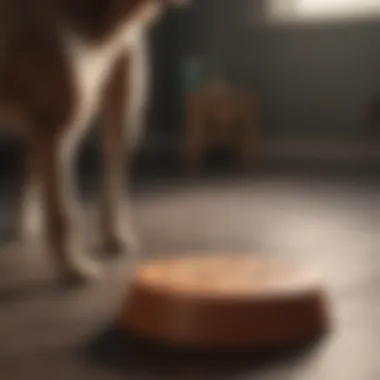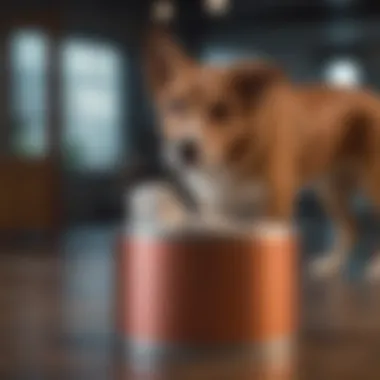Understanding Canine Loose Stool: Causes and Solutions


Intro
Loose stool in dogs is a matter of concern for many pet owners. It is not only uncomfortable for the dog, but it can also signify underlying health issues that may need attention. To effectively address this issue, one must first understand the various factors that contribute to it. This guide aims to provide insights into canine loose stool, empowering pet owners to take informed actions.
Understanding Your Pet
Breed Traits
Different dog breeds have unique genetic backgrounds that can influence their digestion and stool stability. For instance, breeds like Greyhounds may have more sensitive intestinal tracts compared to sturdier breeds such as Labrador Retrievers. Understanding these traits can help owners anticipate potential digestive issues.
Common Temperaments
A dog's temperament often affects its eating habits and stress levels. For example, a nervous dog may exhibit gastrointestinal upset, resulting in loose stools. Recognizing how your dog's character influences its digestive health is crucial for effective management.
Special Needs
Some dogs may have specific dietary or health needs that require special attention. Senior dogs, for instance, might experience loose stool due to age-related digestive issues. Tailoring the diet based on these needs can contribute to overall well-being and specialty in keeping stools firm.
Pet Care Essentials
Nutrition and Feeding Guidelines
A balanced diet is vital for maintaining a dog's digestive health. Choosing high-quality, age-appropriate food can significantly reduce the risk of loose stools. Pay attention to:
- Ingredients: Ensure the food is free from fillers and artificial additives.
- Fiber content: Fiber helps regulate digestive functions.
- Transitioning foods: Gradually changing diets can help prevent digestive issues.
Grooming Tips and Techniques
Regular grooming is essential, especially for breeds prone to anal gland issues. Loose stool can lead to messes that require extra grooming efforts. Regular checks of the anal area can prevent unpleasant situations.
Health and Wellness
Routine vet check-ups are key. They can help detect underlying health problems early. Vaccinations and parasite control can also minimize risks of digestive disturbances that result in loose stool.
Training and Behavior
Basic Training Techniques
Basic training is essential for all dogs. Teaching them commands such as 'leave it' can minimize the chances of consuming something harmful that may lead to gastrointestinal upset.
Behavioral Problems and Solutions
Stress-induced loose stools can sometimes be resolved through behavioral interventions. Identifying triggers and providing a calm environment can ease your pet's anxiety.
Mental Stimulation Activities
Engaging a dog mentally can reduce stress and improve overall health. Activities such as puzzle toys or obedience training can keep your pet's mind occupied and reduce anxiety-related digestive issues.
Engaging with Your Pet
Interactive Games and Toys
Interactive playtime is beneficial for both mental stimulation and bonding. This can alleviate anxiety and improve the dog's digestion, leading to firmer stools.
Safe Outdoor Activities
Going for walks or hikes not only provides physical exercise but also allows for healthy socialization with other dogs. These activities can help in managing stress levels, indirectly benefiting digestive health.
Family-Friendly Pet Interactions
Involving the entire family in pet care is crucial. It promotes a stable environment and encourages proper handling, reducing stress for the dog.
Pet Adoption and Integration
Choosing the Right Pet for Your Lifestyle
Selecting a breed that matches your lifestyle can influence digestive health. Active families might opt for playful breeds, while quieter households may do better with calm dogs.
Preparing Your Home for a New Pet
A well-prepared home can ease the transition for a new pet. Setting up a designated space for eating and resting minimizes confusion and stress for a dog, potentially reducing digestive issues.
Tips for Smooth Foreword
When introducing a new dog to your home, ensure gradual interactions. Monitoring their stress levels during this process can prevent any gastro-intestinal disturbances.


Proper understanding and care can make a significant difference in your dog's health. Always consult a veterinarian for particular concerns related to loose stool.
Addressing canine loose stool is a multifaceted approach. With proper understanding of your pet, a robust care routine, and attention to training and engagement, pet owners can effectively manage and prevent this issue. The journey towards better canine health begins with knowledge.
Prelude to Canine Loose Stool
Understanding canine loose stool is essential for pet owners. It is more than just an inconvenience. Loose stool can indicate underlying health issues that require attention. This section will provide clarity on the topic and build a foundation for recognizing its importance in canine health.
Definition and Overview
Canine loose stool, also known as diarrhea, refers to the condition where a dog passes stool that is too watery or lacks the proper consistency. It can vary in severity, ranging from mild, transient signs to chronic issues that may signify serious health concerns. Loose stool can develop from a variety of causes. These include diet changes, infections, or even stress. Pet owners must be aware that loose stool is not merely a harmless phase. It can lead to dehydration or other complications if not addressed promptly.
Why Understanding Loose Stool is Important
Recognizing and understanding the reasons behind loose stool is vital for several reasons:
- Health Monitoring: Observing changing stool consistency can help track a dog's health status.
- Prompt Action: Early recognition allows for quicker intervention, preventing complications.
- Quality of Life: Maintaining digestive health contributes to a dog’s overall well-being and happiness.
Being attentive to your dog's digestive health can prevent larger health issues down the line.
Understanding canine loose stool leads to better education on diet, symptoms, and when to seek veterinary help. This knowledge equips pet owners to provide a higher level of care, thus enhancing the relationship with their canine companions.
Common Causes of Loose Stool in Dogs
Understanding the causes of loose stool in dogs is key for pet owners. Loose stool can indicate a variety of issues. Identifying the root cause allows for appropriate management and timely intervention. This section will explore significant contributing factors affecting canine health.
Dietary Factors
Diet plays a crucial role in a dog's digestive health. Incorrect food choices can lead to loose stool. Owners must have a clear understanding of dietary influences to maintain their pet's well-being.
Sudden Diet Changes
Sudden changes in diet are common culprits for loose stool. When a dog's food is switched abruptly, its digestive system may struggle to adjust. This can cause gastrointestinal upset. A gradual transition is more suitable. This allows time for the dog's gut to adapt to new ingredients.
Key characteristic: Gradual adjustments are beneficial. Gradual changes reduce stress on the digestive system. Understanding this concept can lead to healthier outcomes.
Low-Quality Ingredients
Low-quality ingredients in dog food can harm digestive health. Foods with fillers and artificial additives lack essential nutrients. Dogs may react negatively to these components, leading to loose stool.
Key characteristic: Quality matters in nutrition. Selecting high-quality, whole food is important. Dogs thrive on diets that support their overall health.
Food Allergies and Intolerances
Food allergies and intolerances can lead to gastrointestinal issues. Dogs may present signs of allergic reactions. Common allergens include beef, dairy, and wheat. This can result in loose stool among other symptoms. Pet owners should monitor their dogs for unusual reactions.
Key characteristic: Observation is key. Identifying specific food intolerances can guide dietary choices. This proactive approach ensures a balanced, suitable diet.
Infectious Agents
Infectious agents can significantly impact a dog’s stool consistency. Understanding their role helps pet owners take preventive measures.
Bacterial Infections
Bacterial infections are a leading cause of loose stool. They can originate from contaminated food or water. Certain strains can affect a dog’s digestive system, leading to diarrhea.
Key characteristic: Awareness can aid prevention. Owners should ensure that food is properly prepared and stored. Keeping food fresh minimizes the risk of bacterial contamination.
Viral Infections
Viral infections also contribute to digestive disturbances. Canine parvovirus is well-known for causing severe diarrhea. Vaccination plays a crucial role in prevention. Regular vet check-ups help ensure that dogs are protected against such viruses.
Key characteristic: Vaccination is critical. Understanding the importance of vaccines is a safeguard against serious health risks.
Parasites
Parasites, such as worms, can disrupt a dog's digestive health. They can lead to malabsorption of nutrients. This results in loose stool and other gastrointestinal issues. Regular deworming and fecal examinations are essential in preventive care.
Key characteristic: Routine checks are vital. Being vigilant about parasite prevention can save pets from discomfort.
Medical Conditions
Medical conditions can create or exacerbate issues with stool consistency. Owners must be aware of potential health concerns.
Gastrointestinal Diseases
Gastrointestinal diseases encompass a range of disorders that affect digestion. Conditions like gastritis can cause inflammation and result in loose stool. It is essential for pet owners to recognize potential signs and seek veterinary advice.


Key characteristic: Acting on signs matters. Early intervention can prevent more severe health problems from developing.
Inflammatory Bowel Disease
Inflammatory bowel disease is a serious condition that can lead to chronic loose stool. It affects the mucosal lining of the intestines. Symptoms may vary, and timely diagnosis is crucial. Dietary management often plays a significant role in treatment.
Key characteristic: Dietary influences are critical. Appropriate food choices can help manage symptoms and improve quality of life.
Pancreatic Disorders
Pancreatic disorders can have a substantial effect on a dog’s ability to digest food properly. Conditions like pancreatitis can inhibit fat digestion. This leads to loose stool and other health issues. Monitoring for symptoms and consulting with a vet are essential.
Key characteristic: Monitoring is essential. Understanding how significant these disorders can be helps owners advocate for their pets’ health.
Symptoms and Identification
Identifying symptoms is crucial in dealing with canine loose stool. Observing your dog closely can reveal important information regarding their health. Understanding these symptoms allows you to take timely action, which may prevent further complications.
Signs Indicating Loose Stool
Frequency of Defecation
Monitoring the frequency of your dog’s bowel movements provides clear indicators of loose stool. If your dog defecates more often than usual, this change can signal a health issue. Regular dogs typically relieve themselves one to three times a day. A marked increase in this frequency suggests something may be wrong.
Frequent defecation can be a sign of an underlying issue such as a dietary intolerance or infection. Observing these habits helps you track changes and provides essential insights for your veterinarian. An increased frequency is beneficial in diagnosing the root cause of loose stool. However, it can also lead to stress for both the pet and owner if left unaddressed.
Consistency of Stool
Consistency is another key measure in assessing loose stool. Healthy stool should have a firm, well-formed quality. Loose stool, by contrast, may vary from slightly soft to watery or even completely liquid. Regularly checking the consistency can help distinguish between mild issues and something more severe.
It is critical to note any differences in consistency compared to your dog's normal pattern. This can be helpful in identifying the severity of their condition. Loose stool is typically a clear indicator that intervention may be needed. However, it is essential to understand that some dietary changes can produce temporary, soft stools that resolve on their own.
Other Accompanying Symptoms
Loose stool often presents alongside other symptoms that can provide more context. Common accompanying symptoms include vomiting, lethargy, and signs of abdominal discomfort. These additional indicators can significantly influence the overall assessment of your dog’s health.
The presence of these additional symptoms highlights the complexity of the issue. For instance, if loose stool accompanies vomiting, the concern for conditions like gastroenteritis rises. Noticing these accompanying symptoms is critical, as they offer more context for the potential seriousness of the loose stool, guiding owners in their decision-making.
When to Consult a Veterinarian
It is vital to consult a veterinarian if your dog exhibits persistent loose stool. This advice becomes especially important if the symptoms last longer than a day or are accompanied by other troubling signs, like blood in the stool or significant lethargy. Prompt professional assessment can prevent serious health implications and ensure proper care and treatment.
Ultimately, being proactive about identifying these signs leads to better health outcomes for your dog. Recognizing these symptoms allows for an informed approach to veterinary care and pet well-being.
Diagnostic Approaches
Diagnosing canine loose stool is an essential process. Understanding the underlying causes can lead to effective treatment. Various diagnostic approaches are used in the veterinary field. These include veterinary examinations and laboratory tests. Each method provides critical data that helps narrow down possibilities.
Veterinary Examinations
Veterinary examinations are a primary step in diagnosing loose stool in dogs. A vet will assess the dog's overall health, paying close attention to relevant symptoms. During this examination, vets will analyze the dog's weight, hydration status, and any signs of distress. These observations are important. They can give insight into the dog's condition and guide further testing.
A thorough history from the pet owner is also essential. Information about recent dietary changes, medications, and any visible symptoms aids in evaluation. This holistic approach gives a more complete picture and can be the difference between a straightforward solution and more complex treatments.
Laboratory Tests
Laboratory tests supplement physical examinations. They provide objective data that aids in diagnosing the cause of loose stool. Several tests are common in this context:
Stool Samples
Stool samples are vital for diagnosing gastrointestinal diseases. They help identify parasites, bacteria, or abnormal contents. This method is popular for its simplicity and effectiveness. Pet owners can often collect samples at home, making this approach convenient. The vet can analyze the sample under a microscope to detect signs of infection or disease.
However, one limitation is the potential for missed parasites if the sample is not fresh or representative. Hence, timing in sample collection is crucial for accurate results.
Blood Tests
Blood tests can reveal underlying health issues. They help assess organ function, nutritional status, and signs of infection or inflammation. The advantage of blood tests is their ability to give a broad overview of the dog’s health. They can detect conditions not immediately observable.
However, these tests can be invasive and may stress some dogs. Additionally, results may vary based on factors like the dog's age, breed, and health history, making interpretation essential.
Imaging Studies
Imaging studies, such as X-rays or ultrasounds, can provide insights into the structure of the gastrointestinal tract. They help identify obstructions, tumors, or other physical abnormalities. The key characteristic of imaging studies is their ability to reveal internal structures non-invasively.
Yet, these studies are often more expensive and require specialized equipment. They may also require sedation, which carries additional risks. Therefore, imaging studies are typically reserved for cases where initial examinations and tests suggest further investigation is necessary.


Effective diagnosis of canine loose stool often relies on a combination of examinations and laboratory tests.
In summary, the use of veterinary examinations and various laboratory tests forms a comprehensive diagnostic strategy. Each method has its strengths and limitations, but together they guide pet owners and veterinarians toward effective management of loose stool in dogs.
Management Strategies
Managing canine loose stool involves various strategic approaches. These strategies are essential for pet owners to understand, as they directly impact a dog's digestive health and overall well-being. Proper management can alleviate discomfort, facilitate recovery, and prevent the issue from recurring in the future. Below, we explore dietary adjustments and veterinary treatments as key components of a robust management plan.
Dietary Adjustments
Gradual Diet Transition
Gradual diet transition is crucial when changing a dog's food. A sudden switch can lead to digestive upset, aggravating loose stool further. The key characteristic of this approach is its gradual nature, allowing the digestive system to acclimate to the new food without shock. It is a beneficial choice as it minimizes potential gastrointestinal disturbances. The unique feature of a gradual transition is the ability to mix old and new food over several days, which balances flavors and textures. Its main advantage is preventing severe gastrointestinal side effects, however, it requires more planning and patience from the pet owner.
Quality Nutritional Choices
Selecting quality nutritional choices plays a significant role in managing canine loose stool. High-quality dog food is made with selected ingredients and typically contains fewer fillers and artificial additives, which can upset a dog’s stomach. The key characteristic of these choices lies in their ingredient integrity, promoting better digestion and nutrient absorption. This makes it a popular choice among conscientious pet owners. A unique feature of high-quality canine diets is their focus on digestible proteins and beneficial fibers. While these nutritional options usually come at a higher price, the payoff includes improved stool quality and overall canine health.
Hydration and Electrolytes
Hydration and maintaining electrolyte balance is fundamental when dealing with loose stool. Dogs can easily become dehydrated due to fluid loss, making hydration a priority. The primary characteristic of ensuring hydration involves providing fresh water at all times; this is critical during an episode of loose stool. Hydration is a popular focus in dog care as it supports overall health and recovery from gastrointestinal issues. A unique feature is the incorporation of electrolyte-replenishing solutions meant for pets, aiding in faster recovery. However, pet owners should be cautious in using these, as improper use could lead to an imbalance or complicate existing medical conditions.
Veterinary Treatments
Veterinary treatments often provide a necessary lifeline when dietary adjustments alone do not resolve loose stool in dogs. Understanding various treatments allows pet owners to make informed decisions about their pet’s health.
Medications
Medications play a significant role in managing chronic or severe loose stool conditions. Often, veterinarians prescribe medications to target specific underlying issues such as infections or inflammatory bowel disease. The key characteristic of such treatments is their ability to quickly alleviate symptoms and restore normal digestion. This makes it a beneficial choice for pet owners seeking immediate relief for their dogs. Unique features include a range of antibiotic and anti-inflammatory options tailored to specific conditions. Its main disadvantage can be potential side effects, making close veterinary guidance essential during treatment.
Probiotics
Probiotics have gained popularity as a supportive measure in canine digestive health. These beneficial bacteria can help restore the natural gut flora, which can be disrupted due to loose stool. The primary characteristic of probiotics is their ability to improve gut health, fostering a balanced digestive environment. This makes them a favored choice for guardians looking to enhance their dog's diet. A unique feature of probiotics is their variety, as they come in many forms, including powders and chews. However, effectiveness can vary depending on the strain, requiring research or veterinary advice to select the best option.
Home Remedies
Home remedies can be an accessible way for pet owners to manage mild cases of loose stool. Options like pumpkin puree or a bland diet of rice and chicken are widely used. The key characteristic of home remedies is their simplicity and the availability of ingredients. This makes them beneficial for many dog owners, especially during minor health issues. Unique features include the customizability to fit a dog’s preferences and dietary needs. However, while these remedies can be effective, they should not replace veterinary guidance when symptoms persist or worsen.
Preventive Measures
Preventive measures are crucial for maintaining canine health and well-being. Loose stool in dogs can become a recurring issue if not properly managed. Taking proactive steps can greatly reduce the likelihood of this condition arising. These measures not only treat symptoms but also address the underlying causes that may lead to loose stool. Pet owners can play an essential role in prevention through knowledge and action.
Maintaining Proper Nutrition
Nutrition plays a vital role in a dog's digestive health. Feeding dogs a balanced diet with high-quality ingredients can prevent gastrointestinal disturbances. Dogs require nutrients such as proteins, fats, and carbohydrates in their meals. If the diet is poor in quality, it may lead to loose stool and other digestive issues.
- Choose high-quality dog foods: Look for options like Royal Canin, Hill's Science Diet, or Orijen. These brands formulate their foods with your dog's needs in mind.
- Regular feeding schedule: A consistent schedule helps regulate digestion. It is beneficial to feed at the same time each day.
- Avoid sudden diet changes: Transition to new foods gradually to prevent shock to the digestive system. Mix the old food with the new over several days.
Regular Veterinary Check-Ups
Routine veterinary visits are essential for preventing health issues, including loose stool. A veterinarian can monitor your dog’s health effectively, catching problems before they escalate. Regular check-ups allow for early detection of potential gastrointestinal issues.
- Vaccinations: Keep your dog's vaccinations up to date to prevent infectious agents that could lead to loose stool.
- Preventive screenings: Blood tests and fecal exams can catch health problems early, allowing for timely treatment.
“Regular vet visits are not just about treatment, they are key to maintaining health and preventing illness.”
Safe Food Practices
Implementing safe food practices is a fundamental step that can safeguard against loose stool in dogs. Poor food practices can expose pets to harmful bacteria or indigestible substances. Keeping food safety in mind can mitigate risks effectively.
- Store food properly: Keep dry pet food sealed and in a cool, dry place to prevent contamination.
- Monitor treats and table scraps: Only give safe treats. Human food can sometimes upset a dog's stomach or create allergies if not known.
- Avoid feeding spoiled food: Always check pet food for expiration dates and signs of spoilage before serving.
By emphasizing all these preventive strategies, pet owners ensure the well-being of their canine companions and mitigate the risk of loose stool.
Culmination
Understanding canine loose stool is crucial for pet owners. This condition is often a symptom of larger health issues or dietary mismanagement. Recognizing the significance of loose stool helps owners take timely action. By tolerating ongoing loose stool, a dog could suffer unnecessary discomfort. Intervening early can avert complications and promote overall wellness. It is essential not just to see loose stool as a mere inconvenience but as an indicator of potential underlying problems.
In this article, we explored various causes and management strategies related to canine loose stool. We discussed dietary factors, infections, and medical conditions that lead to this issue. Recognizing symptoms allows pet owners to make informed decisions. Gradually implementing dietary adjustments and regular check-ups contribute to prevention and management.
"A proactive approach is key in managing your dog's health conditions, including loose stool."
Equipped with this information, pet owners are better positioned to address the issues. The knowledge empowers owners and promotes better health for their pets.
Recap of Key Points
- Loose stool can signal underlying health issues or dietary problems.
- Early identification of symptoms leads to better management and outcomes.
- Diet plays a vital role; watching ingredients and transitions is important.
- Regular veterinary check-ups are crucial for maintaining canine health.
- Effective treatments range from dietary changes to medication.
Encouragement for Ongoing Education
Continuous education is important for all pet owners. The evolving understanding of canine health means that new information emerges frequently. Staying informed allows owners to adjust practices and provide better care. Engaging with veterinary professionals, reading reliable resources, and joining discussions with other pet owners can enhance knowledge.
Informed pet ownership leads to healthier dogs and better quality of life. By deepening your understanding of canine loose stool and other health concerns, you can foster a more robust, responsive relationship with your dog. This commitment to learning ultimately benefits both the pet and the owner.



